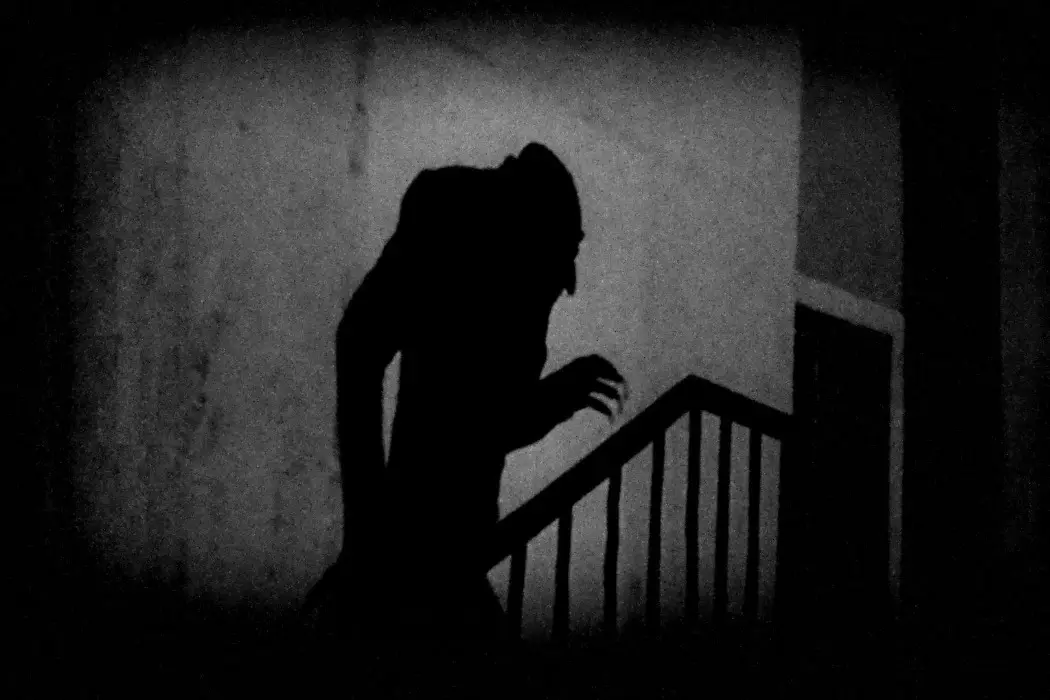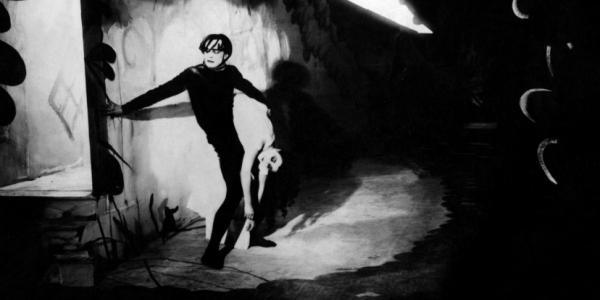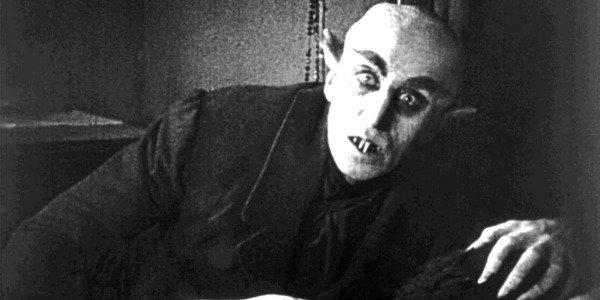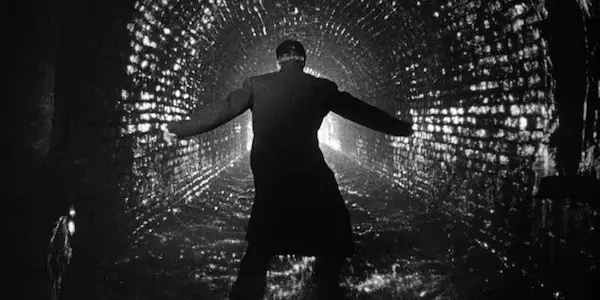The Beginner’s Guide: German Expressionism

Zac Hestand earned a BA in Film from the University…
The dictionary defines Expressionism as “a manner of drawing, painting or sculpting in which forms derived from nature are distorted or exaggerated and colors are intensified for emotive of expressive purposes”. As I scrolled down the dictionary, other definitions appeared such as “a symbolic or abstract representation of reality” and “distorting objects and events in order to represent them by a character through a literary work”. All the definitions of this word best expresses one of cinema history’s well-known film movements; German Expressionism.
The First World War proved to be a catalyst for this movement. This first modern war with planes, tanks and poisonous gases, destroyed the country. Lives on both sides were lost and as with all of these kind of global catastrophes, art is produced to make sense of it all, with the nightmare imagery that real life provided. On the American front, the aftermath brought forth the term “the Lost Generation”, which produced the great Ernest Hemingway and the male face of the Jazz Age, F. Scott Fitzgerald. While the Americans emphasized realism in art, the Germans went into the dark, labyrinth of the subconscious.
Post-War Despair
On the German front, from the end of the war through the 1920s, the German state was referred to as the Weimar Republic, named for the city of Weimar (where the constitutional assembly first took place). With the nation in rubble, the Weimar Republic faced countless obstacles from inflation, anarchist groups, blame for the country’s defeat in the war and the terms of the Treaty of Versailles (sign on the dotted line or we will invade again).

Decades prior, Austrian Sigmund Freud developed psychoanalysis and paved the way for dream interpretation, among other studies. Dreams, as we know, come from our subconscious thoughts. In that realm, reality is distorted. Whether it is the landscape or color scheme, the world we developed is a bit off. The Expressionists brought those nightmares out of the world of dreams, and put them into paintings, the written word, stage and the new medium of film. Inspired by Freud, and under this new government, arts of all mediums flourished.
Literature and the theatre saw the work of Thomas Mann and Ernst Toller emerge. Toller, who would write many works on the theme of psychological collapse, first wrote on the horror of his wartime experience in his play, Transformation. Mann would frequently write in a pessimistic tone of Germany’s failure with society. Themes from these novels can be found in German Expressionism, while the imagery can be traced to the avant-garde movement of Dadaism. Dadaism is where the artist aims to reject logic and reason. As found in Psychology, the subconscious does not follow logic or reason, so your art is able to be expressed with only the limits of the human mind as a barrier.
Film was still a very young art form at this time. French siblings, the Lumière brothers, developed the medium in the 1890s with their “actualities” (no plots, they just filmed people doing mundane things), magician Georges Méliès pioneered special effects and narrative with A Trip to the Moon, while American D.W. Griffith pioneered editing. The Germans brought to this medium techniques that predated everything from Italian Neorealism, to New Hollywood or French New Wave. The techniques used by these artists proved influential to myriad genres, filmmakers and gave innovative techniques still used today (the moving camera, in particular).
Shadows to Create Mood
Given the fact that these films are in black and white, the films could not adhere to the “colors are intensified definition of expression for emotive purposes. However, they could use the black and white palette to its greatest advantage, with shadows. The German Expressionist use of shadows to intensify emotive and expressive moments are instrumental in audience absorption in the films. Two films that use shadow to create mood are both considered by many to be the essential German Expressionism films, The Cabinet of Dr. Caligari and Nosferatu.

Both films fall into the category of horror. The Cabinet of Dr. Caligari tells the story of a hypnotist (Werner Krauss) who uses his hypnotic skills on a somnambulist (Conrad Veidt) in order to commit murder. The film applies the Expressionistic modus operandi with its distorted buildings, odd angles and heavy uses of black in both shadows and clothing choice. A murderer (with black hair, black clothing and very pallid skin) lurks in the shadows waiting for victims. The shadows create a world of fear, darkness and despair, while the distorted shapes show something is not right in the world.
Nosferatu is an unauthorized adaptation of the novel Dracula. Bram Stoker’s widow did not allow for a movie adaptation, but director F.W. Murnau thought, “Screw it. I’ll make it anyway, but change a few things.” Which is why in his version we have a Count Orlock instead of Count Dracula. The plot of Nosferatu and Dracula are virtually identical, so I’ll spare you the plot synopsis. However, the story is categorized as a horror film given the vampire subject matter. Like The Cabinet of Dr. Caligari, the use of shadow plays a part in the creation of ambience.
As a vampire, Count Orlock is a creature of darkness. He needs the night to move around, giving the makers of the film many chances to apply shadows to create that fear of a monster concealed in the darkness, patiently stalking their victims. Much in line with the sleepwalker killer, Count Orlock’s strong pallid complexion stands in contrast with the heavy use of black, making those two out-of-place with the background, to further askew these worlds.
Early Fantasy and Sci-Fi
To continue with the theme of how groundbreaking this movement was, German Expressionism did not only use horror to show distorted realities, but also fantasy and sci-fi. Both directed by Fritz Lang, the fantasies Die Nibelungen: Siegfried and Die Nibelungen: Kriemhild’s Revenge (one long film split into two) and the sci-fi Metropolis continued to expand the possibilities of the movement.
The two fantasy films when combined together, create a five-hour sword and sorcery epic. The film is based on an over one thousand-year old Epic Poem called Nibelungenlied. It’s the story of a king and a princess, with loads of dragons, dwarves, swordplay and copious monsters. Lang creates a world of literal magic and wonder, unlike the reality where the audience resides, and takes them to an incredible, dreamlike world lost through time.

Alternatively, Metropolis takes the viewer to the technological horrors of the future. The film shows a totalitarian society where the poor are sent to work in an underground factory and remain there day in and day out. The wealthy get to stay above ground and enjoy their life doing frivolous things. Things change when a robot goes awry, building on the fear of technology. These films show dragons and robots going against humans, battles that were uncommon and unheard of at the time on the big screen. Like Georges Méliès, Lang as a disciple of the Expressionists, took special effects to a whole new level to show frightening worlds on screen.
Leaving Germany
The German Expressionist movement began from the ruins of WWI and lasted until the early 1930s with the sound era. The most notable Expressionist film of the sound era is Lang’s M, a thriller about a town tormented by a child killer. Unfortunately, the rise of the Nazi party led to the death of this movement. The Nazi party wanted to use film to promote their cause, and had no use for Freudian dream analysis made by people the party wouldn’t associate with such as Lang (Jewish) and Murnau (homosexual). These filmmakers, and others, fled to Hollywood.
The German Expressionist hand-print first showed up in the Universal monster movies. Films like Dracula and Frankenstein, while absent of German filmmakers, were influenced by them. They were able to create those distorted shadows in the mildly uneven castle structures, in order to heighten the fear of these monsters, much like Expressionism had done in films decades prior. The shadows continued in the next decade with the Film Noir genre.
Film Noir took the Expressionistic lighting techniques (Noir means black, after all) to emphasize the genre’s use of shadow. Like Expressionism, these films were shot in black and white, and used to its full potential. Like the German movement, Film Noir deals with the psychological aspects of their characters, and the subconscious. Not in the use of dreams, but humanity’s more primal urges of violence and sexual desires; recurring themes in Noir. Characters are usually detectives, roaming the urban jungle, going deep into the shadows to face villains with these primal urges. Lang even made his own Film Noir with The Big Heat.

The movement left a strong impression on a young Alfred Hitchc*ck. In 1924, he went to Berlin to work as an Assistant Director and co-screenwriter on a British-German production called The Blackguard. When not on set, he frequented the German cinema and became enchanted by the form. Hitchc*ck would adopt German set and lighting techniques for his film, The Lodger, and continue using them with his film Psycho. The blurred images in the infamous shower scene pays homage to blurry images used in Nosferatu.
The shadows, distorted realities and slanted architecture continued in the decades to come with other directors. Orson Welles used Expressionistic shadowing in Citizen Kane and Carol Reed would do the same with The Third Man. Welles utilized the technique in the film’s flashback sequences to give this story of a life wasted a dreamlike, detached quality. While Reed used it to add menace to the criminal underworld and to create a more stark contrast between his two main characters.
German Expressionism: Final Thoughts
The German Expressionists are an integral part of film history. They didn’t just stop with 1930s Universal monster movies and 1940s-1950s Film Noir, but continued to find their place in the world of color film too. The film, Brazil, gives several nods to Metropolis with its set design, totalitarian society and a protagonist motivated by his dreams. A flying hero in fantasy, but listless office worker in reality. While the killer in The Cabinet of Dr. Caligari bears a striking resemblance to Tim Burton’s protagonist in Edward Scissorhands.
The Germans made beautiful paintings in motion, and that imagery continues to inspire and be used in film. Genres and movements are always re-emerging (like the Neo-Noir) or receiving homage from a new generation (there’s a lot of love for 1980s and ’90s things these days). With this striking imagery and themes of the subconscious, it may be time for either a revival, or to keep with the 2010s, homage to these great concepts.
Are you interested in early German film history? Are there areas you wished I covered? Please leave a comment below.
Does content like this matter to you?
Become a Member and support film journalism. Unlock access to all of Film Inquiry`s great articles. Join a community of like-minded readers who are passionate about cinema - get access to our private members Network, give back to independent filmmakers, and more.
Zac Hestand earned a BA in Film from the University of Nevada Las Vegas, and MA in English from the University of Sheffield. He is currently at work on his first book.













